November 10, 2010 - Two beetles trapped in Mobile County, just north of Grand Bay, have been confirmed as redbay ambrosia beetles. The specimens were collected and identified by Dr. John Riggins from Mississippi State University and confirmed by the USDA Animal and Plant Health Inspection Service (APHIS), Plant Protection and Quarantine (PPQ) section. This is the first confirmation of the presence of the beetle in Alabama.
Introduction: The redbay ambrosia beetle, Xyleborus glabratus Eichhoff, was first detected in the US in a survey trap near Port Wentworth, Georgia in 2002 (Rabaglia 2005). By 2003, this Asian beetle and its associated fungus (Raffaelea lauricola T. C. Harr., Fraedrich & Aghayeva) had caused substantial mortality of redbay (Persea borbonia (L.) Spreng.) within a 40-mile radius of the initial trap detection (Douce and Johnson 2005), but the cause of the mortality was unknown at that time. By 2005, Xyleborus glabratus was found to be consistently associated with unusual redbay and sassafras (Sassafras albidum (Nutt.) Nees) mortality in an expanded area of coastal South Carolina and Georgia. In Florida, unusual mortality of redbay was first reported in the spring of 2005 at the Timucuan Ecological and Historic Preserve in northern Duval County, and the presence of X. glabratus was confirmed at this site in October 2005. Currently, the range of X. glabratus and associated redbay mortality continues to expand in Florida and the coastal Southeast. This ambrosia beetle introduces a vascular fungus (Raffaelea lauricola) into its host, causing infected redbays and other hosts in the Lauraceae to wilt and die within a few weeks or months. This insect and disease complex has collectively been named “laurel wilt” (Fraedrich et al. 2008).

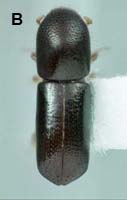 Xyleborus glabratus female.
Xyleborus glabratus female.
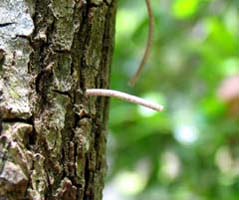 String of Compacted ambrosia beetle sawdust.
String of Compacted ambrosia beetle sawdust.
Xyleborus glabratus is the twelfth species of non-native ambrosia beetle known to have become established in the US since 1990. All are suspected to have been introduced in solid wood packing materials, such as crates and pallets (Haack 2003).
Identification: Xyleborus glabratus is a small, elongate, cylindrical beetle about 2 mm in length (Fig. 1). It is very similar in appearance to the dozen other members of the genus, both native and exotic, already found in Florida. The combination of its almost blackish coloration, nearly glabrous upper surface, and abrupt apical declivity helps to distinguish it from other Florida species, but positive identification will depend on examination by a specialist.
Biology: Very little is known about the biology of X. glabratus at this time, but it is probably similar to other species in the genus. Like other ambrosia beetles of the tribe Xyleborini, X. glabratus does not actually feed on wood, but instead, adults and larvae feed on fungi that are inoculated into galleries in the sapwood by the adult females. Fungal spores are carried in specialized structures (mycangia) found at the base of each mandible (Fraedrich et al. 2008). The generation time is uncertain and likely to vary according to temperature, but observations indicate that brood development can occur in 50-60 days (Hanula et al. 2008). Males of Xyleborus species are generally dwarfed, haploid and flightless (Rabaglia 2005). The vascular wilt pathogen (Raffaelea lauricola) recovered from infested redbays is vectored by X. glabratus. Most ambrosia beetles attack stressed, dead or dying woody plants, but a few - notably several exotic species of the genus Xylosandrus in the southeastern U.S. - will attack seemingly healthy trees and shrubs. In the U.S., X. glabratus has been shown to attack healthy hosts. Although the flight activity of X. glabratus tends to be highest in the summer (Hanula et al. 2008), adult beetles have been successfully flight trapped in low numbers in Florida during both winter and summer months (A. Mayfield and J. Eickwort, FDACS, unpublished).
Common Hosts: Confirmed hosts in the US at this time include redbay and sassafras. The wilt pathogen associated with X. glabratus (Raeffaelea lauricola) has also been recovered from: Persea americana (avocado), P. borbonia (redbay), P. palustris (swampbay), Sassafras albidum (Sassafras), Litsea aestivalis (pondspice), Lindera melissifolia (pondberry) and Cinnamomum camphora (Camphor) ( Mayfield et al. 2008a, Smith et al. 2009). Known host trees in Asia include an Asian spicebush, Lindera latifolia; yellow litsea, Litsea elongata; and sal, Shorea robusta (Rabaglia 2005).
Host Symptoms: Trees freshly attacked by X. glabratus exhibit few external symptoms initially. Small strings of compacted sawdust (Fig. 2) may protrude from the bark at the point of attack, but these strings disintegrate easily and are not always readily apparent. Removal of bark at the point of attack reveals shot-holes from which a dark stain extends into the surrounding xylem (Fig 3A). The stain is the tree’s response to infection by the Raffaelea lauricola fungus, which gradually spreads through much of the outer sapwood (Fig. 3B, C). Attacked trees eventually exhibit wilted foliage with a reddish or purplish discoloration (Fig. 4A). Foliar discoloration may occur first within a section of the crown (e.g., major branch) or simultaneously throughout the entire crown. The foliage eventually turns brown and tends to remain on the branches (Fig. 4B). This wilt scenario is more extensive than the isolated branch “flagging” caused by the black twig borer (Xylosandrus compactus (Eichoff)), which commonly kills twigs and outer portions of small-diameter branches of redbay (Dixon and Woodruff 1982). As the host weakens and dies, it is typically colonized by several other species of ambrosia beetles, including Xylosandrus crassiusculus (Motschulsky), Monarthrum mali (Fitch), Xyleborus affinus (Eichhoff), and several others (Foltz et al 2006).
Ecological & Economic Importance: Given the current pattern of redbay mortality and the rapid range expansion of X. glabratus, this non-native ambrosia beetle and its associated fungus have the potential to seriously affect Lauraceous hosts in the southeastern US. At the site of the initial X. glabratus detection in Florida, redbay mortality has increased from 10% to more than 90% in a period of only fifteen months (Fraedrich et al. 2008). Areas near Hilton Head, South Carolina have experienced nearly complete mortality of the local redbay population. Redbay is important to wildlife as its fruit, seed and/or foliage are eaten by several species of songbirds, wild turkeys, quail, deer, and black bear (Brendemuehl 1990). Larvae of the Palamedes swallowtail (Papilio palamedes (Drury)) feed primarily on species of Persea, thus this butterfly species is likely to be negatively impacted by X. glabratus. There is also considerable concern about the potential impact of laurel wilt on avocado (P. americana), which is an economically important crop in Florida. Avocado trees have been found infected with the R. lauricola pathogen in the field, and laboratory experiments have shown that X. glabratus can successfully bore into avocado trees and introduce the pathogen (Mayfield et al. 2008a, 2008b). However, it is still uncertain what effect laurel wilt will have once it reaches areas of large-scale avocado production in South Florida.
Distribution: Xyleborus glabratus is native to India (Assam, Bengal), Japan (and the Bonin Islands), Myanmar and Taiwan (Rabaglia 2005). The current range in the southeastern US includes most of the coastal and adjacent inland counties in Georgia and South Carolina. In Florida, X. glabratus has been found in the following counties: Alachua, Baker, Bradford, Brevard, Citrus, Clay, Columbia, Flagler, Indian River, Marion, Martin, Nassau, Okeechobee, Osceola, Putnam, St. Johns, St. Lucie, Suwannee, Union and Volusia.
Management: To avoid spreading the beetle and pathogen to new areas, wood or chips from infested trees should not be transported out of the local area where the trees were found. Dead redbay or other Lauraceous tree species cut in residential areas should be chipped and left onsite as mulch, or disposed of as locally as possible. Redbay firewood should not be transported. Personnel from University of Florida-Institute for Food and Agricultural Sciences (UF-IFAS) are currently working on chemical control options for red bay ambrosia beetle.
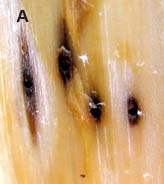
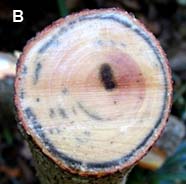
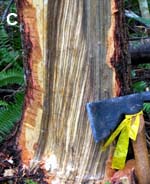 Stained sapwood of redbay caused by Raffaelea lauricola. Fungal infection A) around Xyleborus glabratus entrance holes, B) in stem cross section, C) on lower stem with bark removed.
Stained sapwood of redbay caused by Raffaelea lauricola. Fungal infection A) around Xyleborus glabratus entrance holes, B) in stem cross section, C) on lower stem with bark removed.
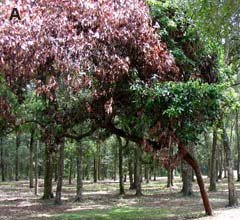
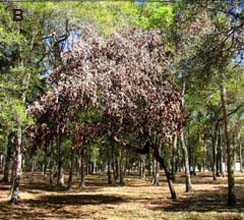 Wilt symptoms of redbay attacked by Xyleborus glabratus and infected with Raffaelea lauricola. A) Sections of crown turning purple to red. B) Same tree eight months later (May 2006).
Wilt symptoms of redbay attacked by Xyleborus glabratus and infected with Raffaelea lauricola. A) Sections of crown turning purple to red. B) Same tree eight months later (May 2006).
The public can help prevent the spread of the redbay ambrosia beetle and laurel wilt disease by following these simple suggestions:
- Become familiar with the signs of laurel wilt disease and redbay ambrosia beetle and be on the lookout for evidence of the pest/disease on your trees.
- Use local firewood only – Do not transport firewood from other states because destructive pests and diseases, such as redbay ambrosia beetle and laurel wilt, can hitchhike into Alabama on infested firewood.
- Do not transport host trees (redbay, swamp bay, avocado, sassafras, pondspice, pondberry and others in the Lauraceae family) unless purchased from a registered nursery.
- Avoid spreading the beetle and pathogen to new areas - wood or chips from infested trees should not be transported out of the local area where the trees were found. Dead redbay or other Lauraceous tree species cut in residential areas should be chipped and left onsite as mulch, or disposed of as locally as possible. Redbay firewood should not be transported.
Additional Resources